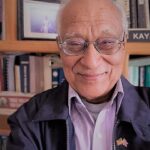Kanhaiya Lal Kayastha worked for the Nepal government from 1960 to 1965 and then joined private practices before coming to the US in April 1977. He has designed and supervised many private and government buildings in and out of Kathmandu, including USAID projects. His first appointment was made by the great leader, the late Ganesh Man Singh when he was the public works minister. He completed the installation of twenty-three drinking water taps in Sankhu village, east of Kathmandu, in 1961, under direct observance of the local leader, Late Hon. Minister Jog Meher Shrestha.
Before 1950, the transportation of all essential goods for Kathmandu Valley was either by porters or through the ropeway-trolley system. Mr. Kayastha’s father was deputed to Dhorsing/Bhimfedi station—the starting point of the ropeway system—and Matatirtha in Kathmandu was the last station. During his early years, Mr. Kayastha’s father taught him at home. He was later admitted to the Juddhodaya Public School, located in a series of abandoned horse stables near New Road, Kathmandu.
In 1974, Mr. Kayastha first visited the USA to attend the AIIE Conference in New Orleans, representing the Nepal Engineers’ Association. In 1977, he returned to join Cal’s Masters in Engineering program. State University, Northridge (1977–1979). He prepared a Structural Building Code for Nepal Project under the guidance of advisor Dr. Roger Di. Julio Jr. In December 1983, he got to hand over a copy of the project to His Majesty King Birendra of Nepal at the Los Angeles World Affairs Council state visit. Nepal enacted a building code in 1994.
In 1981, Mr. Kayastha joined the City of Long Beach after working in a few private engineering offices. He retired from the city’s Planning and Building Department in 2004 as a senior structural engineer. He oversaw the city’s Unreinforced Masonry Retrofit Program and retrofitted more than six hundred existing buildings in the city. He was instrumental in reviewing unique and complex structural projects, including high-rise, residential/commercial, and waterfront structures. He took a lead role in the Los Angeles Regional Uniform Code Program as a member of the ICBO, LA Basin Chapter. He prepared a Manual of Standard Designs Criteria for Public Works construction in 1984.
Mr. Kayastha holds an ME (structure) degree; California state licenses PE (civil), SE (structure), and CA Architect; and ICC Plans Examiner and Building Inspector Certificates and is a Fellow (life) ASCE, Fellow (life) ASNEngr, SE Member SEAOSC (life), and Member SECB. He was a subject specialist for grading the California SE license exams for the Department of Consumer Affairs, State of California.
Mr. Kayastha has written many articles in the field, including, “Earthquake Retrofitting of Schools and Hospitals in Nepal,” ANA, LA, 2007; “Role of Structural Engineers to Create Earthquake-Resistant Buildings and Infrastructure in Nepal,” NRN, Texas, 2010, Nepalnews.com, June 8, 2010; “Earthquake Preparedness and Disaster Relief in Nepal,” NRNA, Kathmandu, October 2011; “Workshop on Consequences of 2015 Nepal Earthquake & Integrated Post-Disaster Management,” (one session chair), Kathmandu, October 2015.
He received the Customer Service Award in 1994, the Supervisors Leadership Institute Certificate from the city manager, a Recognition Certificate from the mayor of the city of Long Beach in 2004, a Lifetime Achievement Award in 2012, and Community Volunteer awards in 2010 and 2013.
Mr. Kayastha served as the president of the America-Nepal Society of California in 1987. He was a founding advisor/donor and Nepali interior temple design architect for Shree Pashupatinath and Buddha Mandir, Norwalk, California. Kayastha resides in La Habra, California. He is married and has three children and four grandchildren.


